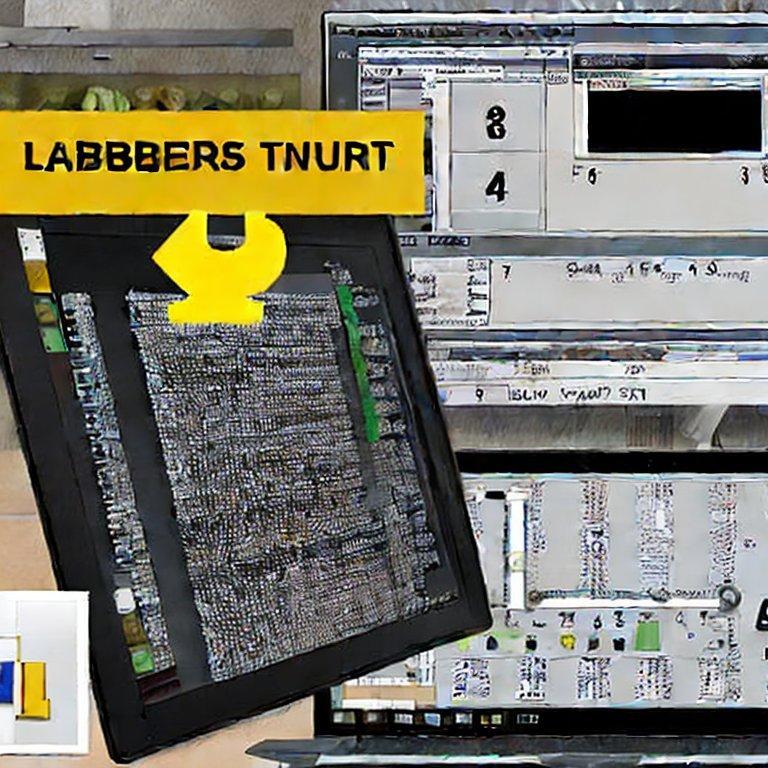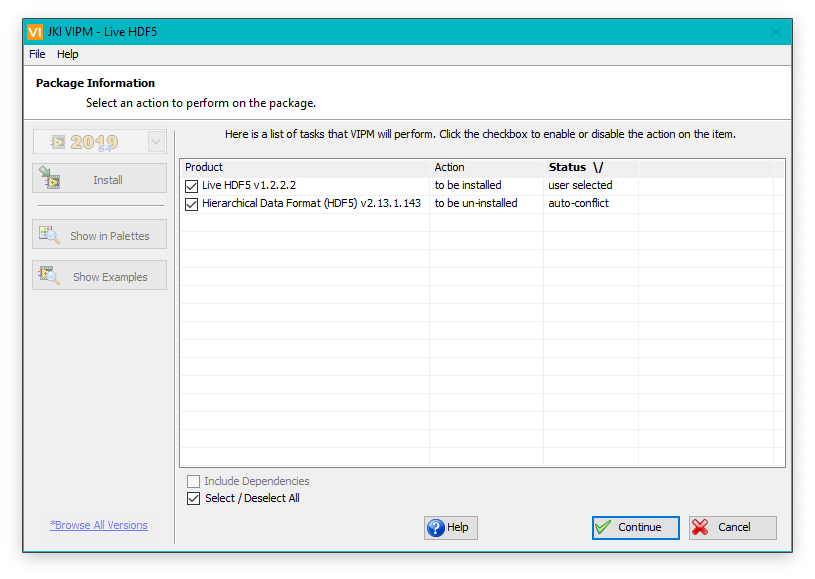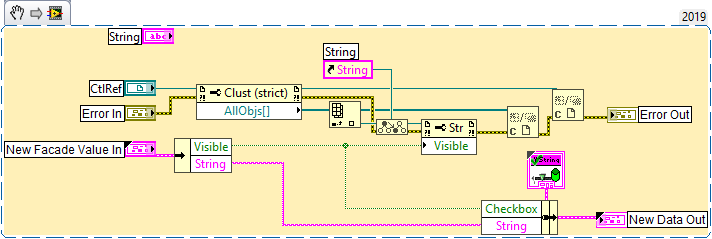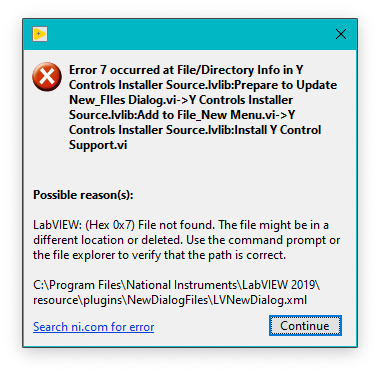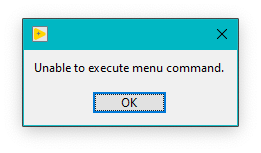-
Posts
440 -
Joined
-
Days Won
29
Content Type
Profiles
Forums
Downloads
Gallery
Everything posted by X___
-
Anyone has had to deal with this type of warning and know how to handle them? I have communicated the associated report several times but have now given up as I am sure NI does have better things to do (say bug fixes). LV 2019 SP1 64-bit on Windows 10.
-
From the foreword of Doom's book: "You owe me a shipped game every week, and if you don’t ship, you’ll get an F." Three classes and 127 games later, almost all of my students went on to jobs in the game 13 industry, no mean feat with a game design degree, and many of them credit the painful time constraints of the class. Terror works. I recommend it." I wonder how that applies to IDE development :-)?
-

NI abandons future LabVIEW NXG development
X___ replied to Michael Aivaliotis's topic in Announcements
I am reading through that lingo and am trying to extract the substance. What I read is that she was hired by NI for a specific job, did (or not) do it and was, if not fired, at least forced into a situation which led to her resignation after about a year on the job. That sounds rather short to me, but it is true that I am not privy to the way things are working on modern corporate boards. Maybe that is the new trend. I suspect there is more to it, and that her opinion that the business was run in a very outdated manner (saying that on a podcast sounds to me very non-politically correct) may have been the main reason. After all, her title is/was Chief MARKETING Officer, not Chief OPERATING Officer. Then there is the question of whether the "Good Ol' Boys" club might have reacted unkindly to a female outsider (I am not clear what her Dell and Rack Space background means in terms of her tech-savvyness. After all, she appears to have a BA in architecture and seems to only have held marketing positions). -

NI abandons future LabVIEW NXG development
X___ replied to Michael Aivaliotis's topic in Announcements
A new chapter in the NI saga? Found in a recent SEC disclosure (I was trying to figure out whether the slow increase in NI stock value since last November was due to something else than the recent announcement that they were firing 10% of their employees to increase the shareholder happiness): "On January 3, 2021, Carla Pineyro Sublett, the Company’s Senior Vice President, Chief Marketing Officer, and General Manager of the Portfolio Business, and a named executive officer, notified the Company of her intent to resign from the Company, effective February 1, 2021, to pursue other opportunities." Who is Carla? Well, she is Mrs Super Green in the flesh: Carla Piñeyro Sublett - NI, first ever Chief Marketing Officer for NI. Intrigued, I looked around and found a couple of (moderately) interesting podcasts: Carla Piñeyro Sublett - Top podcast episodes (listennotes.com) in which she sounds like a very capable lady, and confess that she "discovered" that the company was in need of not just a rebranding (which she carried out brilliantly, we will all agree) but a complete reform. Her decision seems to indicate that that opinion might not have sounded too great to her top brass colleagues... I want to believe she was sincere when she says (said) that her customers are amazing people (a little bit emphatic, are we not?), and that they should be empowered (hence the picture of someone I assume is a customer "engineering ambitiously" on the landing page). I am not sure whether that meant "listened to", but if that was it, she definitely was onto something. NI: if your customers don't think you have what it takes to provide them with the tools they need to stay on the top, what do you think will happen? And if you don't want this to happen, what do you think you need to do? -
Consider yourself lucky. It could have been all green... super green.
-
Are you forcing a conflict with Martijn Jasperse's H5labview package, or is this something made up by VIPM?
-
Free is maybe pushing it. Zero technical support without a SSP would be an appropriate model associated with open source. Of course this wouldn't prevent a vibrant community support (independent from NI) from existing, but this is not what the big industrial companies using LV would go for. They would remain NI's proverbial cash cows. I think the misunderstanding on the corporate side of why open source is beneficial for code safety and reproducibility is understandable, as I can witness the same ambivalence if not resistance in academia. As for NXG and webUI (or whatever they call it now), as discussed elsewhere, it looks like NI doesn't have the resources to bring the vision (whatever it was originally) to fruition, and their recent decision to abandon it will probably lead (or has already led) to morale cratering and talent effusion, so I wouldn't hold my breath... One thing I'd add to the list is this: stop the yearly versioning breaking backward compatibility. This is frankly moronic and the clear and only reason why this exists is NI pricing scheme. Adopt the scheme suggested in the first paragraph and this can go right away.
-

NI abandons future LabVIEW NXG development
X___ replied to Michael Aivaliotis's topic in Announcements
Sounds like King Louis the XIV's court. If someone had just pointed out that the natural next step of such an IDE was to introduce "text shortcuts" to diagram objects, they were quite a short distance from reinventing a text-based programming language. Brilliant! -

NI abandons future LabVIEW NXG development
X___ replied to Michael Aivaliotis's topic in Announcements
Yeah, well, when was the last time NI asked users what they were expecting in a IDE UI? Or what they did or did not like in the mock up designs they were cooking up? I am sorry, I forgot about the "Idea Exchange" forum, which had so many transformative effects on the development of subsequent LabVIEW versions... Of course, ultimately this is probably not what killed NXG (the dislikes of a few old geezers for the IDE). -
Following paul_cardinale's review of my demo, it turns out there was no glitch after all (well, in my understanding or attention level, maybe).
-
Sent as a PM. Also, is there a way to drop a Y Control in an array (or cluster)?
-
LV 2019 SP1f1 64 bit crashed upon closing my first Y Control... but seems to have recovered fine. So, I can now resize objects within a Y Control cluster, but there seems to be a glitch (race conditions?) in the Process New Value.vi: When the user changes the checkbox (for visibility) to True, the string is hidden and reciprocally. Am I missing something?
-

NI abandons future LabVIEW NXG development
X___ replied to Michael Aivaliotis's topic in Announcements
More on this saga, picked by chance in a Forums thread (https://forums.ni.com/t5/LabVIEW/Save-the-progams-user-interface-as-picture-or-serve-it-as-a-web/m-p/4106252?profile.language=en Future of Web Module In essence, the loop is looped and we are back to LabVIEW Web UI, released what, 10 years ago? The roadmap is pretty unclear past 2021... -
cf Brian Powell referring to the "hackish" nature of XControls in the infamous NXG obituary thread...
-
1. I removed LVNewDialog.xml before re-installing 1.0.0.2 and got this: which, after I pressed continued, left the installer window opened in a stopped state, but at least now the help is back in the menu (but in Help>>Y Control, not Help -> New -> Y Control as you have it in the Readme.txt) However, the File>>New... dialog is now empty, so removing LVNewDialog.xml is definitely not the thing to do (putting it back resolves the issue but is missing the Y Control item). 2. Re-uninstalling Y Control Support now LEAVES the Help >> Y Control menu but nothing happens when selecting it: 3. Re-reinstalling 1.0.0.2 restores the Y Control item in the New... dialog box...but removes the Help menu! Getting somewhere?
-
Still can't seem to be able to access the Help. Certainly not in the Help -> New -> Y Control -> Y Controls menu and the chm file still doesn't work for me? It seemed quite straightforward when I first installed it, but maybe the UNinstall step messed up with something? I just uninstalled 1.002 and tried again the release from post 22 and am without an easy way to find Help within LV (and the chm file is not working anymore as a standalone) 😞
-
How do I access the help again? It worked fine in the previous version, but is nowhere to be found in the new one, and the chm help file in the installer doesn't work as is...
-

NI abandons future LabVIEW NXG development
X___ replied to Michael Aivaliotis's topic in Announcements
One more of those dead links on NI's website then... and no information whatsoever. Strangely enough, I never got a "We'd love to hear your feedback" pop-up on that page. 🙂 -

NI abandons future LabVIEW NXG development
X___ replied to Michael Aivaliotis's topic in Announcements
Not if you select VHDL -
Playing around with it. It looks like, as for X and Q controls, compound controls need to be bundled up into a cluster. As a result, the facade is rigid, in the sense that when dropping an instance of the Y control, I cannot adjust the components of the control (or the whole control itself for that matter) unless I modify the definition of the control itself. This is fine for a "one of" control, but somewhat of an issue for something intend to be generic. As an example, I was trying to try out the package with a simple string with visibility checkbox. Once dropped on a FP, neither the checkbox nor the string can be resized. This type of ability (or lack thereof) is one of the things which immediately cooled my enthusiasm for the X and Q controls. I may be missing something though.
-

NI abandons future LabVIEW NXG development
X___ replied to Michael Aivaliotis's topic in Announcements
Online shopping for this product is currently unavailable? -

NI abandons future LabVIEW NXG development
X___ replied to Michael Aivaliotis's topic in Announcements
I wouldn't use a language which is based on a lot of inaccessible C++ code for mission critical software... like driving a space rocket, for instance. I have encountered a lot of "corner cases" in the math routines which had probably some trivial algorithmic flaws at their core, but this was not possible to detect (let alone correct) until I drove the code in the ground, so to speak. One more reason to open the belly of the beast. -

NI abandons future LabVIEW NXG development
X___ replied to Michael Aivaliotis's topic in Announcements
That may explain things then. I am not a channel wire convert, use VIM occasionally and have stayed clear from classes (and thus interfaces). Which I guess excludes me from the conversation? Some dialogs are obviously LabVIEW-built, and have aged pretty badly. The GSW is a recent example of accelerated obsolescence. But as far as I know, the universal answer to requests and suggestions has been: "NI has other priorities and limited resources". How could it be otherwise indeed? Maybe, just maybe, tapping in a free multiplier of resources could change things? It is not that there are only negative examples out there of open source programming language development... But I'd understand that a scalded cat fears cold water. -

NI abandons future LabVIEW NXG development
X___ replied to Michael Aivaliotis's topic in Announcements
Sure, why not rewrite Linux or Android in LabVIEW too... 🙂 XControls are not standard LV objects. Can't put them in array, they have all kinds of limitations, and while I understand that they were created at great cost and with the best intentions, they essentially failed (I think I have developed one and concluded that this was not worth the effort - in large part because of the impossibility to array them). I'd say pessimism seems warranted after the failure of NXG and the complete lack of a clear roadmap (this is what I was referring to with the term quixotic - with a typo). I have since cut NI some slack and understood that little guys like me are of no monetary values to them. Fair enough and in any case, this is not the type of programming language I can publish code in since it is hieroglyphics to most. And even that at some point will have no value, as we will just tell Alexa the general features we need in our software, maybe draw a GUI mock-up and a DL network will generate the code... -

NI abandons future LabVIEW NXG development
X___ replied to Michael Aivaliotis's topic in Announcements
There is a problem right there (in the flash light story), but who is really surprised about it? Of course there would be a cost to open sourcing the code: cleaning it up and documenting it as the team fixes things up in the upcoming releases is something that would be expected from a pro team anyway. They wouldn't have to accept any and all contributing candidate, and they wouldn't have to commit any and all contributions. But they might get some good feedback from dedicated believers (see e.g. https://openjdk.java.net/contribute/). At worse none, but that in itself might be a good indicator for management to take a hard look at LV's relevance. They could spin-off improvements to control/indicator modifications to the community and focus on the things that matter most to their core business. You'd be surprised how focused debuggers would be at squishing those pesky bugs of yore... not mentioning expanding the capabilities of LV. There is no guarantee that LV would eventually rule the world (I don't think anyone of us has ever had this dream). But maybe it would give it a chance to not look hopelessly outdated. The real obstacle seems to be the "NI culture". I have no idea what it is, but the recent past has painted it has rather quitoxic if not readily toxic.

